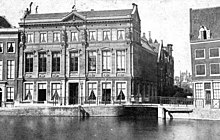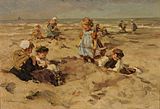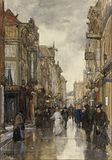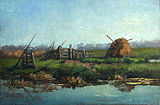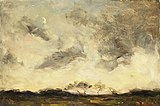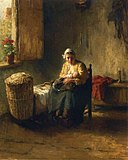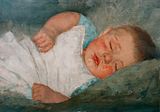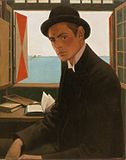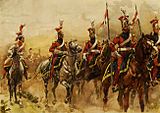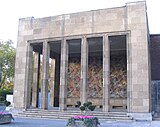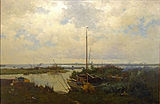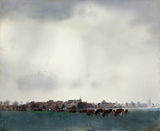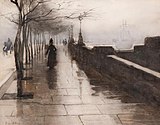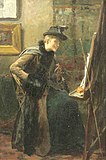Willink van Collenprijs

From left to right: Jan Hillebrand Wijsmuller , Van der Waay, Ferdinand Oldewelt and Ernst Witkamp .
The Willink van Collenprijs is a Dutch art prize that was first awarded in 1880 by the Sociëteit Arti et Amicitiae in Amsterdam. As a sponsorship award for young panel painting artists, it was coveted and was understood as a national counterpoint to the Salon de Paris , which was very popular at the time . Its existence for over 71 years is testimony to a successful art policy on the edge of patronage.
To the prehistory
The Amsterdam painter Wilhelm Ferdinand Willink van Collen (1847–1878) and his wife Anna Bosse were great art lovers. After his death, Willink Collen left the well-known Amsterdam institution Arti et Amicitiae a sum of 30,000 guilders, which was then to be used to support young artists. This also happened against the background of the painting schools existing or operating at the time, such as the Düsseldorf School of Painting , the Copenhagen School and the Munich School , the Grand Ducal Saxon Art School Weimar , the Académie des Beaux-Arts in Paris, the Barbizon School and the Accademia di Belle Arti di Firenze as well as the new French Impressionist Movement to give the Dutch offspring a chance. In the Kingdom of the United Netherlands, there was a problem of promoting art. The promotion of young artists was only possible through private sponsors such as Arti et Amicitiae. The state only stepped in when nothing else worked. This situation only began to change at the end of the 19th century, which was also due to the then King Willem III. decreased.
Influence from Paris
The annual exhibition of the Paris Salon was the most important event for the painters and art world in Europe. Paris had become the center for the art of panel painting. To be able to exhibit there was associated with high demands, which were linked to strict conditions by a jury. Five prizes were awarded. These were two gold medals and three silver medals. In addition, the “Commendation” and the “Honorable Mention” were given.
In the Kingdom of the Netherlands, thanks to the legacy of Ferdinand Wilhelm Willink van Collen, the Dutch answer had now been found. This wasn't the only price; The David Fund still played an important role here, although it only had 10,000 guilders. The pension obtained here was only intended for young and talented artists.
The new art award
The board of directors of the Arti et Amicitiae association decided to hold an annual painting competition for all Dutch artists who were resident in the kingdom and who had not yet reached the age of thirty. The age limit was later raised to 35 years. The pictures had to be handed over unsigned and were then evaluated anonymously by the jury. In addition to the first prize, a bonus was also awarded - quasi as second place - and a commendation was given as third place, which was not always common. This procedure was maintained until 1893. On closer inspection, this roughly corresponds to the tiered pricing of the Paris Salon.
When it comes to the awarding of the prizes, it is noticeable that the jury tended towards the traditional view of art. The jury had to deal with a very special problem. The level of the work submitted was quite variable. In 1891 it was decided to choose a difficult subject for this competition in order to deter painters with insufficient training. In the following year, the jury decided not to award a first prize because, in their opinion, the submitted works did not have "sufficient artistic value". Some of the themes were “Expression in the Head” (1891), “An Event in National History” (1892), “The Life of Willem de Zwijger” (1932) and “Summer” (1935).
No award and its consequences
In 1893 a competition was announced for a mural in an art building. Seven works were received that disappointed. As a result, for the first time in history, neither a prize nor a commendation was given. In 1894 the board decided to use the money from Willink van Collen's fund to purchase the painting “In the Snow” by George Hendrik Breitner , a study trip for three students from the Rijksakademie van beeldende kunsten to Amsterdam during the Easter break and for those living in London Dutch artist to use.
The policy of the board of directors to distribute the money from the fund differently than specified went against the grain of a number of artists. Twenty-nine painters, including celebrities such as Hendrik Willem Mesdag , the brothers Jacob Maris and Willem Maris , Paul Gabriël and Louis Apol drafted a joint letter to protest against this practice. In response to this pressure, another competition was announced in 1896, which was awarded for the last time in 1950. From then on there was only one winner, but several first places were awarded in 1807, 1906 and 1910.
The award of this award lasted 71 years, combined with interruptions, as a consequence of historical events and the awarding policy of the sponsorship.
Award winners
Winner 1880-1893
- 1880 Nicolaas van der Waay
- 1881 no first place
- 1882 Ernst Witkamp
- 1883 Jan Hillebrand Wijsmuller
- 1884 Wally Moes
- 1885 Jan Hoynck van Papendrecht
- 1886 Jan Voerman
- 1887 Henry Luyten
- 1888 Willem Bastian Tholen
- 1889 Johannes Akkeringa
- 1890 Johannes Graadt van Roggen
- 1891 no first place
- No first place in 1892
- 1893 no award of prizes
Winner after 1896
- 1896 Marius Bauer
- 1897 Minca Bosch Reitz , Theo Molkenboer and Joh. Vlaanderen
- 1898 Gerrit Haverkamp
- 1904 Hendrik Jan Wolter
- 1905 Cornelis Vreedenburgh
- 1906 Barend Polvliet and Lizzy Ansingh
- 1909 JG van Caspel , CJ van der Hoef , Georg Rueter and David Schulman
- 1910 Elsa van Doesburgh , Marie van Hove , Bern. A. van Beek and Ed Gerdes
- 1913 Gerard Johan Staller
- 1914 Salomon Garf
- 1917 Nicolas Friedrich Heinrich Cevat , "Riviergezicht"
- 1931 Tinus van Doorn
- 1932 Dick Ket
- 1939 Theo Kurpershoek
- 1950 Henk Willemse
Gallery of outstanding award winners
Bibliographies
- Bley, Britta: From the state to the nation: On the role of art in the development of a Dutch national consciousness in the long 19th century . LIT-Verlag, Münster, 2004, ISBN 3-8258-7902-X .
- Reynaerts, Jenny: The Wide View - Landscapes of the Hague School from the Rijksmuseum. Exhibition catalog. Hatje Cantz, Ostfildern 2008, ISBN 978-3-7757-2270-4 .
- Suyver, Renske: A Reflection of Holland - the Best of the Hague School in the Rijksmuseum. Rijksmuseum Amsterdam, 2011, ISBN 978-90-8689-048-4 .
- Sillevis, John; Kraan, Hans and Dorn, Roland: The Hague School - masterpieces of Dutch painting of the 19th century from Haags Gemeentemuseum. Exhibition catalog. Ed. Braus, Heidelberg 1987, ISBN 3-925835-08-3 .
- Leeuw, Ronald de, Sillevis, John, Dumas, Charles (Eds.): The Hague school - Dutch masters of the 19th century. Exhibition catalog. Gemeentemuseum, The Hague / Weidenfeld & Nicolson, London 1983, ISBN 0-297-78069-7 .
- Wagner, Anna: The Hague School - Dutch painters a hundred years ago. Rheinisches Landesmuseum, Bonn 1972, ISBN 3-7927-0142-1 .
Web links
- Hague School (English)
- Exhibition "Painting of the Hague School"
- Late Hague School (English)
- Mesdag and the “Hague School” dissertation by Gabriele Schmid: Illusion Spaces
Remarks
- ↑ In addition, he also made 5,000 guilders available for the widow's and orphan's fund in order to alleviate the plight of artist families. For more information, see Britta Bley, p. 123.
- ↑ The marriage of the "Düsseldorfer Schule" took place between 1819 and 1918.
- ↑ The golden age of the "Copenhagen School" only lasted from 1770 to around 1850.
- ↑ The Munich School arose from the "Royal Academy of Fine Arts" and had its heyday from 1820 to 1914.
- ↑ It is also known as the Nanem Weimar School. From 1870 to 1900 people turned away from the long-standing academic tradition of painting - neoclassicism - and opened up to Impressionism (German Impressionism) and then to modernism .
- ↑ The "Barbizon School" was active from 1830 to around 1895.
- ↑ The Accademia di Belle Arti di Firence has a long tradition and its time of the new art movements beginning with realism or open-air painting began around 1850
- ↑ The phase of pre-impressionism lasted from 1840 to 1869. Impressionism itself ended in 1889. Then the age of the "Belle Époque" began.
- ↑ Maatschappij 'Arti et Amicitiae' Fund Willink van Collen ( Memento of the original dated December 29, 2015 in the Internet Archive ) Info: The archive link was inserted automatically and has not yet been checked. Please check the original and archive link according to the instructions and then remove this notice. (PDF; 2.9 MB). In: Algemeen Handelsblad of August 2, 1880.
- ↑ 13e Wedstrijd, uitgeschreven door het bestuur van het fonds 'Willink van Collen' ( page no longer available , search in web archives ) Info: The link was automatically marked as defective. Please check the link according to the instructions and then remove this notice. (PDF; 6.9 MB). In: Het nieuws van den dag of December 21, 1891.
- ↑ King Willem III. took care of the recognition of the next generation and thus of art in the country by awarding scholarships and awarding medals. In addition, people abroad adorned themselves with local art and the Netherlands was forced to keep up. This was also reflected in the investments in equipping the new Rijksmuseum in Amsterdam.
- ^ R. Zeitler: The art of the 19th century . Berlin 1966 ( Propylaea Art History, Volume 3)
- ↑ The artists' association Pulchri Studio zu The Hague was more open to newer trends and was therefore very different from Arti.
- ↑ J. Knoef: Van Romantiek dead Realisme. Een bundel art historical opparts. The Hague 1947.

